The AMD Trinity Review (A10-4600M): A New Hope
by Jarred Walton on May 15, 2012 12:00 AM ESTAMD Trinity: Battery Life Also Improved
With all of the changes going into Trinity, one thing that hasn’t changed since Llano is the process technology. Trinity is once again coming on a 32nm process from GlobalFoundries. If we were talking about Intel, Trinity would represent a “Tock” on the roadmap—a new architecture on an existing process. We’ve looked at CPU and GPU performance, and this is a part that’s pretty much universally faster than its predecessor. Given the lengthier pipeline and Bulldozer-derived architecture, I admit that I was concerned Trinity might actually be a step back for battery life; it appears that my fears were unfounded, largely due to the improvements in Piledriver. As usual, we tested with all laptops set to 100 nits brightness in our idle, Internet, and H.264 playback tests. I also ran some additional tests which we’ll discuss in a moment. First, here are the standard battery life results:
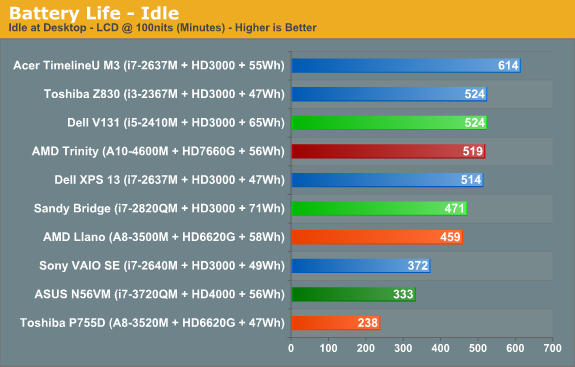
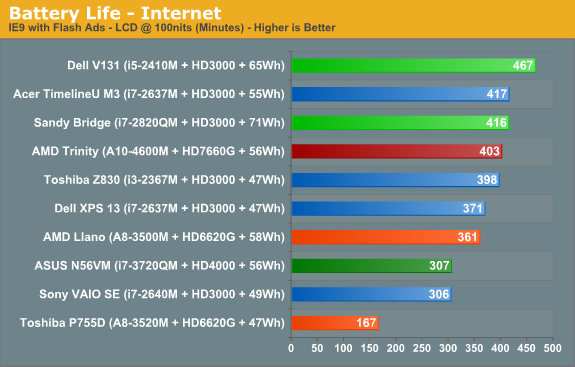
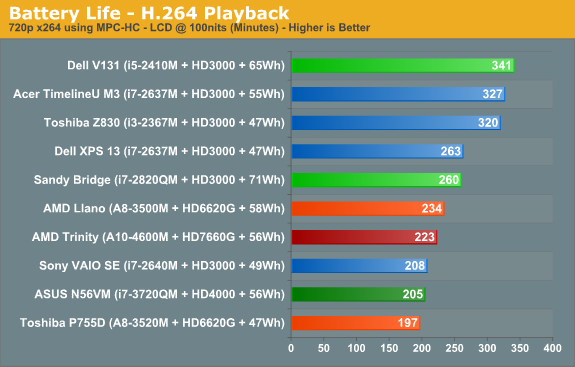
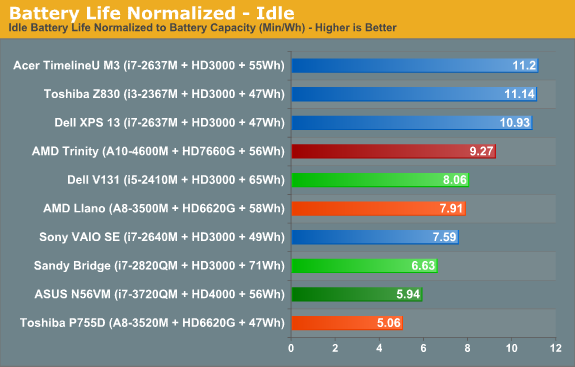

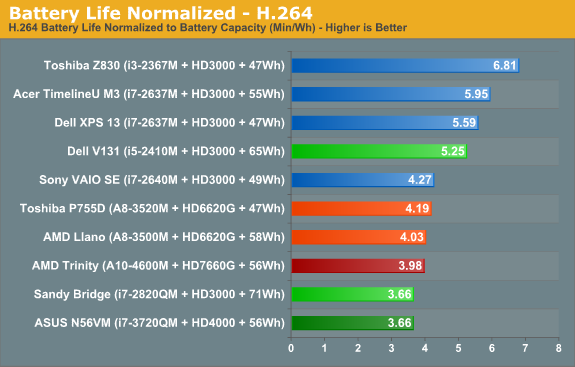
With a similar capacity battery to the original Llano laptop, and the same size 14” panel, Trinity comes out of the gates and posts two clear wins: idle battery life and Internet battery life are both up substantially relative to Llano. In fact, looking at the normalized charts, the only laptops that can consistently beat Trinity are found in Sandy Bridge ultrabooks—we won’t even bother discussing Atom or Brazos netbooks, as they’re competing in a completely different performance bracket. In something of a surprise, H.264 battery life doesn’t see the same benefit unfortunately, and it’s the one discipline where Llano still holds on to a slight lead over Trinity. Sandy Bridge meanwhile has always done very well in H.264 battery tests, and we see that with the Vostro V131 posting a normalized score that’s 30% better than Trinity and Llano. Of course, on the other end of the spectrum we have Ivy Bridge; we’ve only looked at one Ivy Bridge laptop so far, but if the pattern holds than Ivy Bridge will generally be a moderate step back in battery life relative to Sandy Bridge, giving AMD an even larger lead in this area.
We also performed a few other tests that we won’t present in graph form. One set of tests we alluded to earlier: the charts show Trinity with a Samsung 830 SSD, but we also ran tests with an Intel 520 SSD. Idle battery life dropped to 476 minutes (an 8% decrease), Internet battery life checked in at 371 minutes (down 8% again), and H.264 battery life stayed nearly the same at 217 minutes (down less than 3%). If battery life is one of your primary concerns, remember: all SSDs are not created equal!
Another test that we ran is simulated gaming; we looped the four graphics tests in 3DMark06 at 1366x768 until the battery ran out. We’ve run this same test on quite a few other laptops, and Llano initially looked to be far and away the best solution. Later, we discovered that when we tested Llano we were letting the GPU run in power saving mode—basically half the performance you’d get compared to being plugged in. We retested and measured 98 minutes, so the extra graphics performance comes with a heavy cost. We only tested Trinity (and Ivy Bridge and Sandy Bridge) using higher performance graphics settings, and this is one more area where it scores worse than Llano: Trinity managed just 77 minutes. That’s about the same as Ivy Bridge and Sandy Bridge (79 and 73 minutes, respectively), so if you’re after better gaming performance while running off the mains, you might need to keep looking.
Before getting too carried away with the above results, you still need to consider how important battery life is for your usage model. Some people travel a lot and like to go all day without plugging in; others will go from place to place and plug in whenever they’re not on the go. If you fall in the latter category, battery life isn’t usually a problem with any decent laptop, while those looking for all-day computing will definitely want as much mobility as possible. Ultimately, battery life is a factor of battery capacity as well as power optimizations done by the OEMs. We’ve seen battery life improve by as much as 50% when comparing two otherwise similar notebooks, but at least AMD’s reference platform for Trinity delivers a great starting point.
Temperatures and Acoustics
One other item we wanted to quickly touch on is system temperatures. We typically use HWMonitor and check temperatures of laptops under idle and load conditions. We did this with Trinity as well, but unfortunately the current version of HWMonitor doesn’t give us a lot of information. The only temperatures it reports are from the SSD and the HD 7660G graphics—there’s nothing about CPU core temperatures. That means we can’t provide much detail, other than to say that load temperature on the GPU topped out at 71C during extended testing, while the idle temperature was 39C. As usual, temperatures and noise levels go hand in hand, and the low 71C maximum GPU temperature matches up nicely with noise levels that never got above 37dB. It’s not the quietest laptop we’ve ever tested, and surface temperatures can get a little warm, but overall Trinity looks to be a good balance of performance and power requirements, which means quiet laptops are definitely possible.










271 Comments
View All Comments
Kaggy - Tuesday, May 15, 2012 - link
And at lower power consumption.Pantsu - Tuesday, May 15, 2012 - link
Unfortunately for AMD, the processor is only a small part of the laptop BOM. Even if Trinity is cheaper, the difference in the end product is not that big. Still, the mainstream 15" cheapo laptop is perhaps the last refuge AMD has.Looks like Trinity is still the way to go for low end gaming, but it's disconcerting to see HD4000 actually beat it in few tests. AMD really needs to get a better CPU architecture going.
HSA is still long ways to go too, and I just don't see AMD pulling off the necessary developer support for it to really work, unless Intel goes along the same lines, in which case they might as well just give up.
iwod - Tuesday, May 15, 2012 - link
I am guessing Haswell will have some CPU improvement with FMA, New AVX, etc... and 3 times faster Graphics..... I dont see Trinity or what ever behind it having too much hope.I am also wondering if Intel could further improve those games performance with better drivers. Again Intel may have caught up with the hardware department ( The easier part ), their drivers are still lacking behind.
Spunjji - Tuesday, May 15, 2012 - link
I'd like to think that an AMD CPU with their current GCN graphics on a 28nm-or-smaller process would at least be GPU competitive with Intel. We live in interesting, times, though.duploxxx - Tuesday, May 15, 2012 - link
you can always believe marketing that they will be able to perform that kind of GPU leap while in the past they have always struggled to enhance. Sure the 4000 is already getting better (near Liano perf) it only shines in the few synthetical benchmarks and where the AMD is limited to CPU performance.perhaps try a few higher res games and see how much is left from the Intel GPU...
AMD is limited to memory bandwidth, Intel will suffer from the same.
cyrusfox - Tuesday, May 15, 2012 - link
So when will I be able to find a good trinity laptop with backlit keyboard in a small 13" form factor or preferably smaller. I would like to upgrade from brazos, and brazos 2.0 isn't going to hack it.JarredWalton - Tuesday, May 15, 2012 - link
This is the hard part: just about every OEM that makes an AMD laptop ends up targeting the budget market, and in that market they cut every corner possible. Forget quality LCDs (which would add around $10 to the BoM for most laptops), forget better build materials, and forget amenities like backlit keyboards. Oh, I'm sure someone will make a Trinity laptop with a backlit keyboard, but then they'll probably ask $800 for it. HP has their Envy 14 coming in "Sleekbook" trim that might get you a backlit keyboard, though--and it's price starts at $700.FrontBoard - Tuesday, May 15, 2012 - link
Trinity is the name of a river in Texas, just as Comal and Brazos are. That is likely where the codenames come from.kevith - Tuesday, May 15, 2012 - link
Thanks!JarredWalton - Tuesday, May 15, 2012 - link
For the record, I *did* know that AMD is grabbing names of rivers. I guess it could be better stated: "I wonder if AMD was trying to have a secondary meaning with their codename." And it was a nice hook for the conclusion. :-)